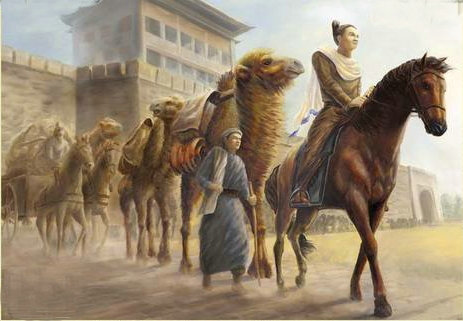China's vast western region is accessible to travelers along the classic Silk Road, although historically, the trade route was never called such until a German geographer gave it that romantic name in the late 1800s. In AD 200, this transcontinental route linked the Roman Empire in the west with the imperial court of China. Trade along the route was carried on by foreign traders who belonged to neither of the two old empires.
Before the discovery of the sea route to India, the Silk Road was the most important connection between the East and West. It experienced its last great era during the time of the Mongol Empire. This ancient trade route starts in the old capitals of Luoyang and Xian (then called Chang'an), reaches the Yellow River at Lanzhou, then skirts westward along deserts and mountains before dividing into three routes at the oasis of Dunhuang. The great part of the Silk Road threads its way through Xinjiang. Ancient travelers left behind many historical records and invaluable relics.
History

Named in the middle of the 19th century by the German scholar, Baron Ferdinand von Richthofen, the Silk Road, which is regarded as the greatest East-West trade route, was first traveled by Zhang Qian when he was sent on a diplomatic mission to the Western Regions in the Han dynasty (206 BC-AD 220). The Silk Road was the information super highway of its age, serving as the conduit not only for goods but also for the transmission of knowledge and ideas between east and west.
The Rise of the Silk Road
The Silk Road originated in the 2nd century BC from a desire for military and political purpose instead of for trade. In order to seek allies to against Xiongnu repeated invasion, a court official named Zhang Qian was sent by Han Wudi to the Western Regions. However, on the way to the Western Regions, the Xiongnu captured Zhang and detained him for ten years. Escaped from Xiongnu's detention, Zhang Qian continued his journey to the Central Asia. While at that time, the local rulers were satisfied with their status and refused to ally with Han Empire. Although the mission failed in its original purpose, the information Zhang Qian conveyed to China about Central Asia, and vice versa, made people in each area desire goods produced in the other. Silk that was favored by Persians and Romans, inaugurated the trade along the Silk Road.
While when the Silk Road was first established, silk was not the chief commodity. Han dynasty made very little profit from it until the Romans were fanatic about silk that the large profits came in. The Roams love silk so much that they even exchanged silk for its weight in gold. During the Tang dynasty, thirty percent of the trade on the Silk Road was comprised of silk.
Prosperous as it was, the operation of the Silk Road always be influenced by the political developments. A stable state could ensure the smooth trade on this road, while the troublous one would hurt. When Zhang Qian opened this road, the Han dynasty and the empire of Parthia in Persia just achieved their golden ages, which give a favorite financial support to the smooth development of this route.
